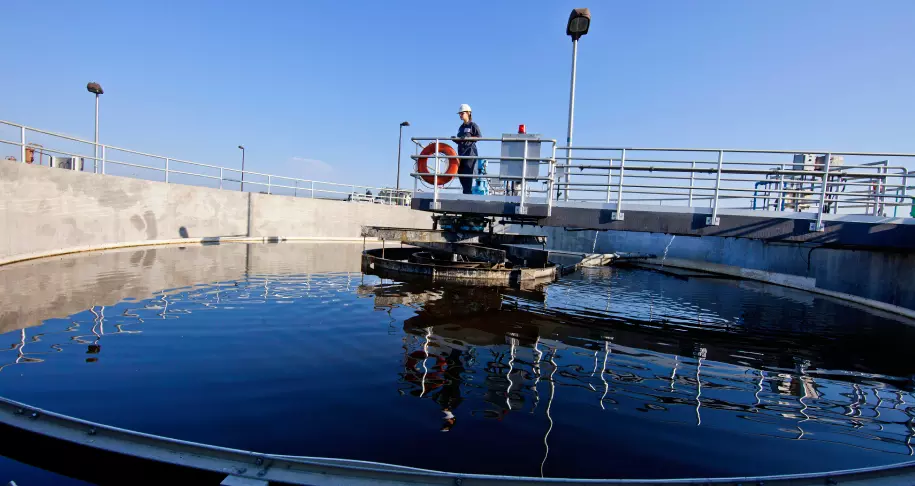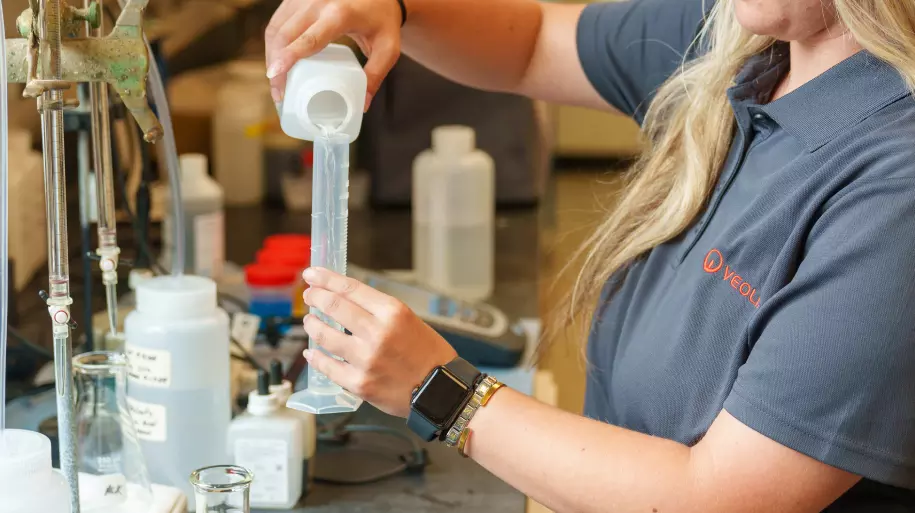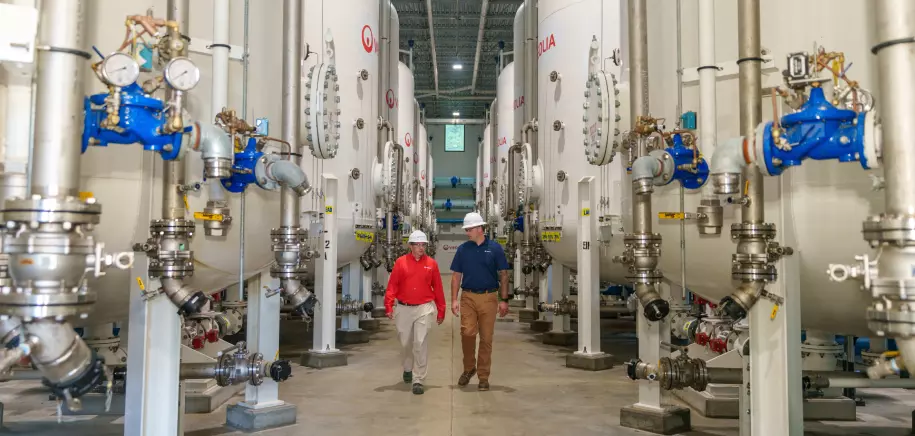Reading time 8 min. #water #city #community #industrial

Carol Walczyk
Senior Vice President Municipal Water, inside the Business Support & Performance department, Veolia
Today, I am seeing that the issue of PFAS—per- and polyfluoroalkyl substances—has become a major concern for all communities and industries that care about water quality. PFAS, often called ‘forever chemicals’, are found everywhere in our daily lives: medications, clothing, cookware, toothpaste, and more. As a result, they are present in our water resources, posing a public health risk to local areas. With the detection of PFAS contamination in both drinking water and wastewater, the pressure on public and private decision-makers to act quickly and effectively is increasing. Local governments and industries now face several key challenges: ensuring safe tap water, complying with new regulations, and protecting public health. The numbers speak for themselves: 80% of micropollutants in groundwater come from everyday products, and regulations are getting stricter worldwide. In this context, it is essential to rely on innovative and proven solutions to ensure water that is clean, compliant, and safe. At Veolia, I support municipal and industrial stakeholders every day in implementing concrete and innovative solutions to effectively address PFAS pollution, from detection to treatment of these persistent substances.
In this article, I explain how to turn this challenge into an opportunity for sustainable performance.

Key points to remember
Recent scientific studies show that PFAS pose a risk to health and the environment, with confirmed presence in both drinking water and wastewater.
Regulations on PFAS are becoming stricter, requiring high-performance treatment solutions.
Solutions must be adapted to specific needs: municipalities (drinking water and wastewater) or industries (process water).
Investing in PFAS treatment is becoming essential for regulatory compliance.
Veolia is developing cutting-edge technologies, brought together in BeyondPFAS—a comprehensive offering for detecting, treating, and removing PFAS from water, backed by international expertise.
Whether you are a local authority or an industrial operator, discover how our approach can transform water pollution management and address your compliance, safety, and sustainability challenges. Continue reading to explore our practical solutions.
A Major Public Health Challenge for Communities
Through my work supporting local authorities and industries with water treatment challenges, I have noticed a growing awareness around PFAS. But what exactly are PFAS?
These substances have been widely used in industry for their non-stick, flame-retardant, and water-repellent properties, and today they are found everywhere: in heat-resistant textiles, cookware such as frying pans, food packaging, cosmetics, and ultimately in our water resources.
This presents a significant challenge for communities. PFAS do not break down naturally—hence their nickname, “forever chemicals”—and they accumulate in the environment over time. According to scientific studies, they may expose the population to health risks, such as increased cholesterol levels and higher risk of certain cancers. For elected officials and local decision-makers, this means a direct responsibility to their constituents: ensuring tap water that meets new regulatory requirements. For industrial players, the challenge is to treat their process water and manage contaminated waste.
The good news is that for the 20 PFAS currently regulated in French drinking water, there are solutions to detect them, even though the technical complexity of these molecules requires a tailored approach. Unlike traditional pollutants, PFAS resist conventional treatment methods and require advanced technologies for effective removal.
Innovative Technological Solutions Adapted to Every Context
For municipal drinking water, our solutions focus on treatment using activated carbon adsorption and membrane filtration technologies. These systems make it possible to achieve the strictest regulatory thresholds, including the French limit of 0.1 μg/L for the sum of 20 PFAS.
On the industrial side, the approach varies by sector. In aerospace or chemicals, where concentrations can be very high, we deploy high-temperature thermal destruction or electrochemical oxidation processes.
"The ability to combine these solutions allows us to build on our experience and adapt to diverse situations."
(Séverine Dinghem, Director of Business Support and Performance, Veolia)
Given the complexity of the challenge, Veolia has developed BeyondPFAS, a comprehensive offering to support municipalities and industries in detecting, treating, and removing PFAS and other micropollutants. This solution draws on the Group’s international expertise and innovative technologies, adapted to each regulatory and environmental context.
Managing Costs and Meeting Regulatory Requirements
Financing is always top of mind when I speak with decision-makers. Investments to treat PFAS can indeed be significant, but they are becoming unavoidable with tightening regulations. Costs depend on the size of facilities and networks, level of contamination, and technologies used, but the stakes are high: meeting current standards, avoiding penalties, and maintaining user trust.
In Europe, more than 23,000 sites are affected by PFAS pollution, and regulations are rapidly evolving to set ever-stricter limits. The European Directive 2020/2184 on the quality of water intended for human consumption has been revised to monitor PFAS in water analyses, targeting 20 molecules. In France, a decree has set limits since 2023: 0.1 μg/L for the sum of 20 PFAS.

In the United States, the EPA (Environmental Protection Agency) has set even stricter thresholds for certain molecules. These regulatory changes are accelerating, and communities need to prepare now.
For municipalities, several funding mechanisms exist -in addition to low-interest loans: grants from water agencies, European cohesion funds, and public-private partnerships. It is important to include these investments in a long-term strategy, as the costs of non-compliance can far exceed preventive investments.
For industries, the “polluter pays” principle fully applies. Companies now need to budget for PFAS treatment as a dedicated item, just like other environmental obligations.
Global References Demonstrating the Effectiveness of Our Solutions
My teams and I have had the opportunity to deploy our PFAS technologies on three continents, with results that speak for themselves.
In the United States, Veolia has become the leading private operator of water services, already having set up about thirty regulated PFAS treatment sites for our customers in six states. In 2018, Veolia began a proactive monitoring campaign to assess the presence of PFAS in drinking water. As early as 2019, the Group worked closely with local authorities in several states (New York, New Jersey, Pennsylvania, etc.) to launch a PFAS management plan for drinking water wells, anticipating the standards set by the states and the EPA.
In June 2025, we inaugurated one of the largest PFAS treatment plants in the United States, in Delaware, capable of treating nearly 120 million liters of water per day, ensuring high-quality drinking water for more than 100,000 residents. This project demonstrates our ability to operate at an industrial scale while meeting economic constraints.
In Europe, Veolia anticipated regulatory changes by conducting an unprecedented campaign in 2023 to detect PFAS in the 2,500 drinking water production sites managed by the Group in France, achieving 99% compliance with the applicable standard. This proactive approach is in line with the revised 2020 European “drinking water” directive, which requires systematic monitoring of 20 PFAS from 2026. In France, the installations of the Syndicat des Eaux d’Île-de-France (SEDIF) use innovative membrane technologies to treat a wide range of micropollutants, including certain PFAS.
These international references allow us to capitalize on best practices and adapt our solutions to the specificities of each territory.

Let’s protect your grid from PFAS, together
Fighting PFAS pollution is certainly a technical and financial challenge, but it is also an opportunity for communities to become pioneers in ecological transformation. Solutions exist; they are proven and adaptable to all situations—whether to protect citizens’ drinking water or to treat industrial effluents.
Anticipation remains key to success: the sooner you act, the more you control your costs and regulatory compliance.
Contact us to evaluate together the solutions best suited to your area.
Carol Walczyk
Senior Vice President Municipal Water, inside the Business Support & Performance department, Veolia
Carol Walczyk is a civil engineer with over 35 years of experience in planning, designing, building and operating environmental infrastructure in the United States and Europe.

The information contained in this document is based on Veolia Group’s knowledge and understanding of the scientific, regulatory, and technical fields discussed, as of the date of publication. No contractual commitment or offer is made on this basis, and no guarantee is given as to the accuracy, completeness, or suitability for any intended use of the information provided.
This article contains text partially generated with the assistance of generative artificial intelligence, based on the Group’s knowledge base. The content has been reviewed and validated by the expert.

